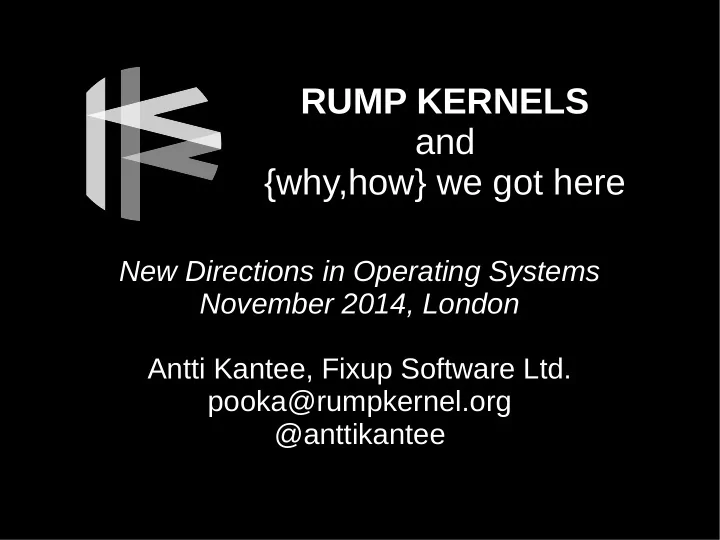

RUMP KERNELS and {why,how} we got here New Directions in Operating Systems November 2014, London Antti Kantee, Fixup Software Ltd. pooka@rumpkernel.org @anttikantee
Motivations ● want to run an application, not an OS ● want a better operating system ● “operating system gets in the way”
FIRST HALF what is an operating system
Summary of OS's ● drivers – for enabling applications to run – n*10 6 LoC ● optional goop defining relation between drivers and applications – for protection, resource sharing, ... – 10 3 – 10 5 LoC
application application driver driver driver kernel driver driver
application application driver driver Server (“OS”) driver kernel driver driver
application application server server driver driver server driver kernel
application application application driver driver driver cpu core cpu core cpu core
application driver driver driver driver kernel
application application driver driver driver kernel driver driver
SECOND HALF what is a rump kernel
callers (i.e. “clients”) file systems device drvs syscalls ... TCP/IP rump kernel hypercall interface hypercall implementation platform
rump (n): small or inferior remnant or offshoot; especially: a group (as a parliament) carrying on in the name of the original body after the departure or expulsion of a large number of its members
rump kernel (n): small or inferior remnant or offshoot; specifically: a monolithic OS kernel carrying on in the name of the original body after the departure or expulsion of a large number of its subsystems
A rump kernel does not provide threads, a scheduler, exec, or virtual memory, nor does it require privileged mode (or emulation of it) or interrupts > runs anywhere > integrates into other systems
Wait, that doesn't explain where the drivers come from < anykernel (NetBSD)
AN EXAMPLE! same thread throughout entire stack application(s) unmodified POSIX userspace code (10 n lines) userspace libraries libc rump kernel calls syscall traps unmodified NetBSD code (~10 6 lines) file systems device drvs syscalls ... TCP/IP rump kernel Platform-independent glue code glue code (~10 4 lines) hypercall interface platform-specific hypercall implementation code (~10 3 lines) e.g. Genode OS, Xen, platform userspace, bare-metal,
THIRD HALF (with operating systems, expect the unexpected) how rump kernels happened
Step 1: RUMP (2007) userspace fs framework application (userspace part) rump kernel VFS emustub unmodified file system driver ad-hoc shims hypercall implementation NetBSD userspace userspace syscalls, VFS, etc. kernel userspace fs framework file system (kernel part) driver
Step 2: UKFS (2007) application (e.g. fs-utils) UKFS rump kernel VFS emustub Q: how hard can implementing unmodified file system driver a few syscalls be? ad-hoc shims A: very hypercall implementation userspace userspace kernel
Step 3: a lot application / service (2008 - 2011) hijack ● support for all driver syscalls, vfs, etc. subsystems ● isolation from the host ● stable hypercall interface file systems device drvs syscalls ... TCP/IP ● anykernel completed rump ● production quality kernel ● rump kernels used for glue code testing NetBSD ● no libc for rump kernels, hypercall interface applications ran partially on the host hypercall implementation userspace
Step 3.5: visions (not an actual step) ca. turn of the year 2011/2012: “An anykernel architecture can be seen as a gateway from current all-purpose operating systems to more specialized operating systems running on ASICs. The anykernel enables the device manufacturer to provide a compact hypervisor and select only the critical drivers from the original OS for their purposes. The unique advantage is that drivers which have been used and proven in general purpose systems, e.g. the TCP/IP stack, may be included without modification as standalone drivers in embedded products.”
Step 4: portability to POSIX 2007-2012, 2012- buildrump.sh (2012-)
4.4STEP: beyond POSIX (201[234])
Step 5.1: rumprun file systems device drvs syscalls ... (2013, 2014) TCP/IP rump kernel glue code hypercall interface hypercall implementation platform
application(s) userspace libraries libc rump kernel calls syscall traps Step 5.2: rumprun file systems device drvs syscalls ... (2013, 2014) TCP/IP rump kernel glue code hypercall interface hypercall implementation platform
FINAL HALF conclusions & other tidbits
All le gory technical details: http://book.rumpkernel.org/ 2 nd edition is work in progress Will be available as free pdf, hopefully printed too
Community ● http://rumpkernel.org/ ● http://repo.rumpkernel.org/ – BSD-licensed source code ● http://wiki.rumpkernel.org/ ● rumpkernel-users@lists.sourceforge.net ● #rumpkernel on irc.freenode.net ● @rumpkernel
The actual conclusions
You can make an omelette without breaking the kitchen!
Recommend
More recommend